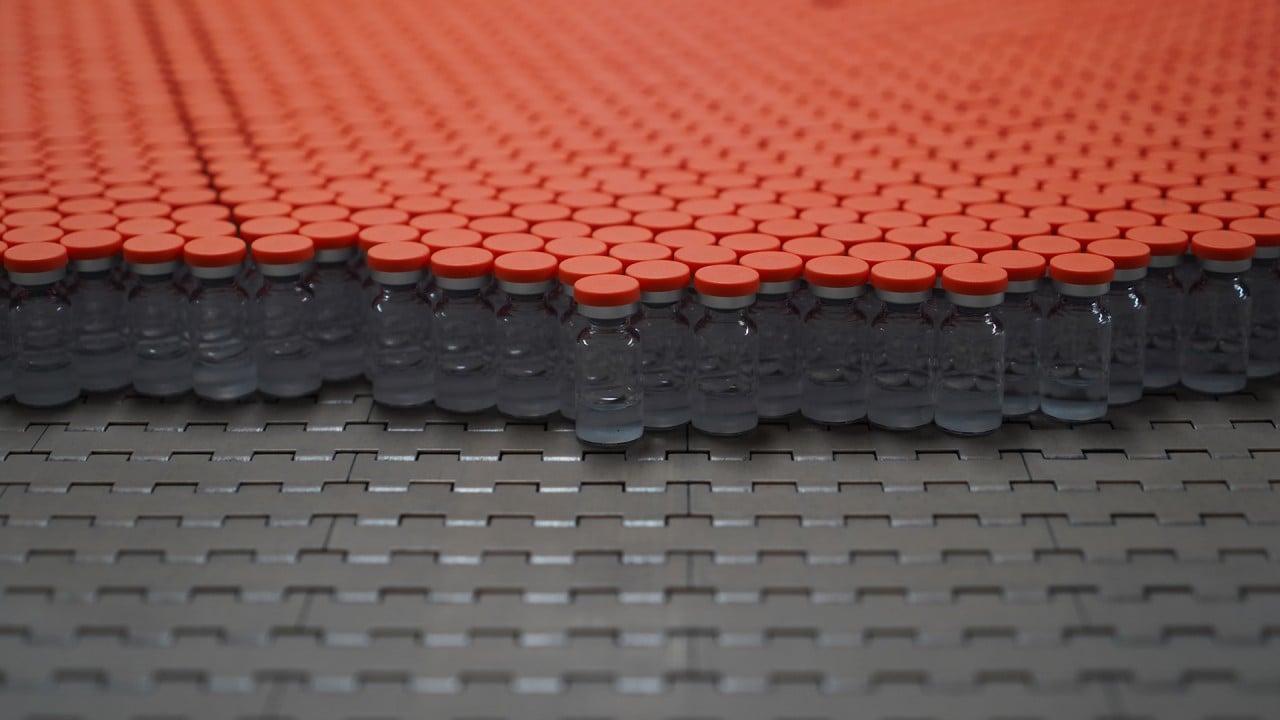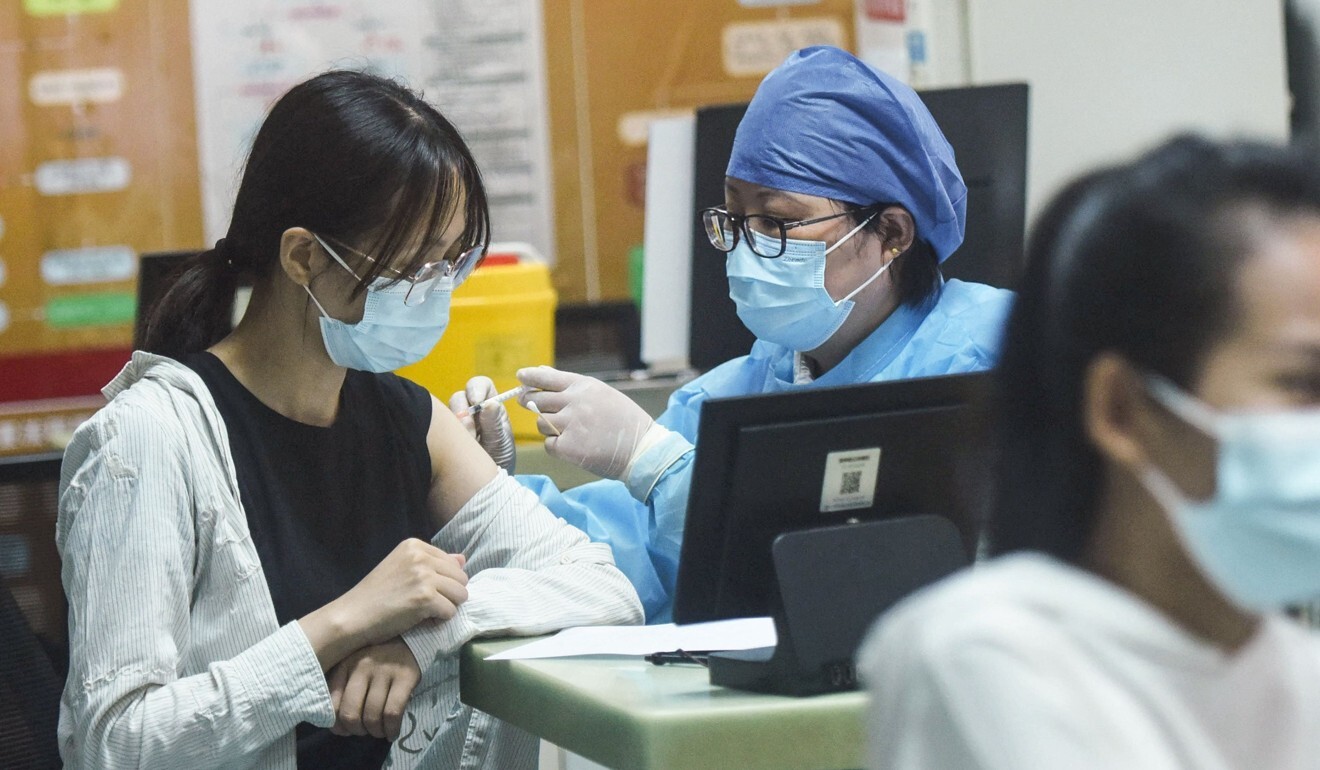
02:35
Inside a plant in China producing the WHO-approved Sinovac Covid-19 vaccine

China announced that it has achieved a key milestone, with 630 million people inoculated against Covid-19 by Thursday, as the country reached its target of vaccinating 40 per cent of the population by the end of June.
The country administered 24.7 million vaccine doses on Thursday alone, a record since the inoculation drive began in late March, bringing the total number to more than 1.12 billion.
Daily vaccinations accelerated from slightly over 2 million doses in late March to an average of more than 18 million in June as manufacturers scaled up production and local Covid-19 outbreaks startled residents into getting the shots.
“Over 40 per cent of the total population has been vaccinated. This is an important step towards establishing herd immunity,” according to a statement carried by state broadcaster China Central Television on Friday.
“This joint effort by the vaccine developers, manufacturers, regulators and supervising authorities of key sectors of vaccine production is a very important factor to guarantee the supplies of Covid-19 vaccines,” Cui Gang, a senior official with the commission, told CCTV.

02:35
Inside a plant in China producing the WHO-approved Sinovac Covid-19 vaccine
The next target is the vaccination of 70 per cent of China’s 1.4 billion people by the end of the year, but that will not automatically translate into so-called herd immunity – a state that can limit the spread of the virus, or lifting any restrictions, experts said.
With new virus variants circulating and the effectiveness of vaccines against them uncertain, it remains unclear when restrictions will be eased.
“Vaccine coverage and efficacy of the vaccine directly affect the level of immunity in the population and thus also the time to lift restrictions,” said Marco Ajelli, an epidemiologist and associate professor at Indiana University-Bloomington.
“It is also important to consider that current vaccines are designed for historical SARS-CoV-2 [the coronavirus that causes Covid-19] lineages and thus may or may not have lower efficacy against future variants.”
He said China still needed to maintain social distancing, mask mandates and closed borders to prevent major outbreaks.
Ajelli and a team of researchers from Shanghai’s Fudan University and the Bruno Kessler Foundation in Italy established a mathematical model and found that without such restrictions, China’s vaccination programme alone would be too slow to delay the epidemic or help reduce the Covid-19 burden.
“Even if the daily vaccination capacity could be increased to 30 million doses, in the absence of non-pharmaceutical interventions, we estimate that over 7.7 million deaths would still occur,” the researchers wrote in a paper that was published in Nature Human Behavior on Wednesday.
“Similar patterns are estimated for the number of symptomatic cases, hospitalisations and ICU admissions.”
“Our study shows that non-pharmaceutical interventions are still key and will continue to be key until a large fraction of the population is protected,” Ajelli said. “Until that point, there is a need to rely on non-pharmaceutical interventions, either pre-emptive ones such as border control, and or reactive ones like widespread testing.”
Beijing claimed “phase victory” after curtailing outbreaks in central Hubei province last year and outbreaks in different provinces were successfully controlled with strict lockdowns, robust contact tracing and fast testing.
The borders are largely shut with limitations in visa, flights and strict testing and quarantines while mass inoculation campaigns proceed.
Government-affiliated epidemiologist Shao Yiming has said the country will need to vaccinate up to 85 per cent of its population – about the size of everyone older than age 15 – to achieve herd immunity.
But some experts worry that even with high vaccination rates, herd immunity is still uncertain because of multiple factors, including the unclear nature of how current vaccines can block virus transmission.
The three most widely used vaccines, manufactured by Sinovac and Sinopharm, reported overall efficacy rates of 51 to 79 per cent against symptomatic cases, but data against asymptomatic infection was unclear.

“Even if 80 per cent of the population is vaccinated with Sinopharm or Sinovac, the herd immunity might not be sufficient to prevent transmission or outbreaks,” said Jin Dong-yan, virologist and professor at the University of Hong Kong.
Jin said China has relied on border controls to block the virus and expected them to remain in place “at least for months” because vaccinated people are still susceptible to infection, particularly to the new variants.
“That’s the real concern. The Chinese authorities know that. They provide less benefits to the fully vaccinated people. The hidden worries are that Chinese vaccines are not sufficiently efficacious,” he said.
With a high vaccination rate and improved protection, Covid-19 can become endemic – meaning the virus will still spread in some populations but with a predictable infection rate, similar to seasonal flu, said Dr Zhang Wenhong, head of the infectious diseases department in Shanghai’s Huashan Hospital.
“Some people thought vaccination was to eradicate an infectious disease, but scientists around the world believe it was very unlikely. We don’t need to eradicate coronavirus, we just need to eliminate the pandemic,” Zhang said on Thursday.
“In future, after we bring down the pandemic to the prevalence level of a seasonal flu through universal vaccination and increased protection of vaccines, the opening of the world will then be inevitable.”

While achieving a high vaccination rate is crucial, improving vaccine protection should be on the agenda of Chinese authorities, Jin from HKU said.
Chinese developers could come up with a better vaccine – by either increasing the dose or using high quality adjuvant, or by combining and mixing vaccines to achieve better protection, he said.
In the United Arab Emirates and Bahrain, Pfizer shots are offered as a booster for those already vaccinated with Sinopharm doses after the health authorities found some vaccinated people did not have strong antibodies.
“That kind of remedial method is really helpful to build up herd immunity in the Chinese community. Either sequential use of different vaccines, for example, one additional Pfizer or the same vaccines for the third time serving as a booster might be very helpful,” Jin said.
“This is the right direction to remedy the deficiency of these Chinese vaccines.”